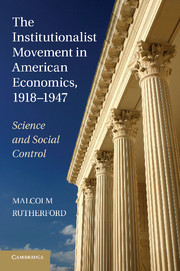Book contents
- Frontmatter
- Contents
- List of Tables
- Acknowledgments
- PART ONE INTRODUCTION
- 1 American Institutionalism in the History of Economics
- 2 Understanding Institutional Economics
- PART TWO INSTITUTIONALIST CAREERS
- PART THREE CENTERS OF INSTITUTIONAL ECONOMICS
- PART FOUR CHALLENGES AND CHANGES
- PART FIVE CONCLUSION
- Archive Collections Consulted
- References
- Index
- Titles in the series
2 - Understanding Institutional Economics
Published online by Cambridge University Press: 03 May 2011
- Frontmatter
- Contents
- List of Tables
- Acknowledgments
- PART ONE INTRODUCTION
- 1 American Institutionalism in the History of Economics
- 2 Understanding Institutional Economics
- PART TWO INSTITUTIONALIST CAREERS
- PART THREE CENTERS OF INSTITUTIONAL ECONOMICS
- PART FOUR CHALLENGES AND CHANGES
- PART FIVE CONCLUSION
- Archive Collections Consulted
- References
- Index
- Titles in the series
Summary
If institutionalism today is associated with a single figure, it is with Thorstein Veblen, but the terms “institutional economics” or “institutionalism” to denote an identifiable movement within American economics did not come into common use until the interwar period. Veblen's most substantial and influential writing appeared in the years between 1898 and 1914, and although Veblen was far from uninvolved, it was those influenced by Veblen's ideas, such as Walton Hamilton, Wesley Mitchell, and J. M. Clark, rather than Veblen himself, who played the major role in defining and promoting what became known as institutional economics (Rutherford 2000a, 2000b).
“INSTITUTIONAL ECONOMICS”
The very first mention of the term “institutional economics” in print occurs in a footnote in Walton Hamilton's 1916 article dealing with the work of Robert Hoxie (Hamilton 1916a, p. 863, n.5). Hoxie and Hamilton were colleagues for a short time at Chicago, and Hamilton claims that Hoxie called himself an “institutional economist.” Hoxie had been a student of Veblen's at Chicago and was initially much influenced by Veblen's ideas on the effect of the “industrial discipline” on the habits of thought of unionized workers. Hoxie was also a highly regarded investigator of the American labor movement, an influential teacher, and a point of connection between those around Veblen and other students of the labor movement, particularly John R. Commons and some of his students.
- Type
- Chapter
- Information
- The Institutionalist Movement in American Economics, 1918–1947Science and Social Control, pp. 15 - 54Publisher: Cambridge University PressPrint publication year: 2011



